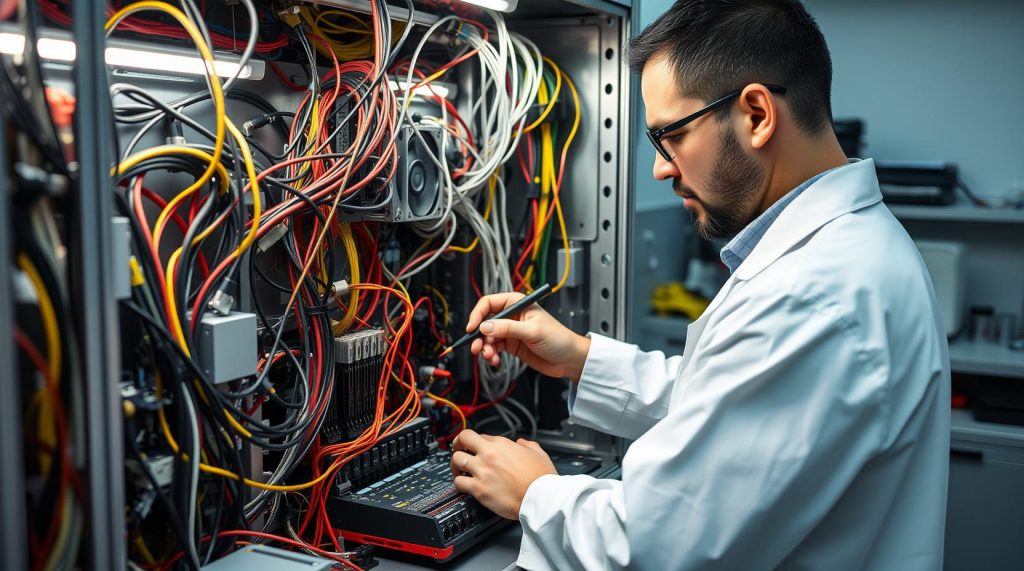Understanding Electrical Equipment Repairs: A Basic Guide
ArticleElectrical equipment is central to various industries, from manufacturing to healthcare, and even home and office environments. However, these devices can experience issues that require troubleshooting, maintenance, or repairs to keep them functioning safely and effectively. This guide provides an overview of common electrical equipment issues, repair tips, safety practices, and when it might be better to replace rather than repair equipment.
Common Electrical Equipment Issues
Electrical equipment can face several issues, often due to wear, improper use, or environmental factors. Common problems include blown fuses, faulty wiring, overheating, and broken connections. Motors may fail to start, or equipment may operate intermittently, which can indicate loose connections or circuit issues. Understanding these common issues can help identify the root cause quickly and inform the necessary steps for repair.
Tips for Repairing Electrical Equipment
When repairing electrical equipment, start by assessing the problem to determine if it’s a minor issue, like a loose wire, or something more complex, such as a damaged circuit board. Use the equipment’s manual for troubleshooting steps and ensure you have the proper tools, such as a multimeter for checking voltage and continuity. Replacing minor components like fuses or switches is often manageable with basic tools, but for complex repairs, consulting a professional may be safer and more effective.
Troubleshooting Electrical Machinery
Troubleshooting is a structured approach to finding faults within electrical machinery. Begin by identifying symptoms, such as strange noises, reduced performance, or power surges. Check the power source and connections first, as loose plugs or damaged cords can be simple fixes. Use a multimeter to test continuity and voltage levels, which can reveal faults in the wiring or components. If basic troubleshooting doesn’t resolve the issue, more in-depth diagnostics may be needed.
Electrical Equipment Maintenance
Regular maintenance is crucial for keeping electrical equipment in optimal condition. Dust and debris can interfere with electrical connections, so clean equipment surfaces regularly. Lubricate moving parts as specified in the equipment manual to prevent excessive wear. Check wiring and connections for signs of corrosion or damage, and replace worn-out components before they fail. A regular maintenance schedule reduces the likelihood of unexpected breakdowns and prolongs equipment life.
Repairing vs. Replacing Electrical Devices
Deciding whether to repair or replace electrical devices depends on the extent of the damage, age of the equipment, and cost of repairs. If the repair costs exceed half the price of a new device or if the equipment is outdated and inefficient, replacement may be the better option. For newer equipment with minor issues, repair is usually cost-effective. Evaluate the benefits of energy-efficient replacements, especially for older devices that consume more power and generate higher utility costs.
Safety Tips for Electrical Repair
Safety is paramount when working with electrical equipment. Always disconnect power before beginning any repairs and verify that the equipment is off by checking with a voltage tester. Wear insulated gloves and use tools with rubber handles to avoid accidental shocks. Avoid working on electrical repairs in wet environments, as moisture increases the risk of electrical shock. If you’re unsure about any aspect of the repair, consult a certified technician to avoid injuries or further equipment damage.

Understanding Electrical Faults
Electrical faults are disruptions in the normal flow of current, often caused by damaged insulation, loose connections, or short circuits. Faults can result in circuit overloads, equipment malfunction, or even electrical fires. Understanding the different types of faults, such as open circuits, short circuits, and grounding issues, helps in diagnosing problems. Addressing faults early on is essential to prevent larger, more costly issues and to ensure the equipment operates safely.
Why Electrical Equipment Fails
Electrical equipment can fail for various reasons, including aging, lack of maintenance, or environmental factors. Components wear out over time, while dust and debris can lead to overheating. Voltage fluctuations and power surges are also common causes of equipment failure, often damaging sensitive components. In some cases, improper usage, such as overloading or poor ventilation, can shorten the equipment’s lifespan. Understanding these failure causes allows for preventive measures to be put in place.
Signs of Electrical Malfunction
Recognizing the signs of electrical malfunction early on can help prevent damage or breakdowns. Common indicators include flickering lights, strange noises, unusual heat, or burning smells coming from the device. If equipment shuts down unexpectedly or frequently trips circuit breakers, this could be a sign of internal faults. Reduced performance, such as slower operation or inconsistent power, also suggests that the equipment needs inspection and potentially repair.
Checking Voltage in Equipment Repairs
Checking voltage is a crucial step in diagnosing electrical equipment issues. Using a multimeter, test for correct voltage levels in different parts of the equipment to pinpoint areas with power loss or instability. Voltage testing helps confirm whether power is reaching essential components, revealing potential faults in wiring or power supplies. Always follow safety protocols when working with voltage testing, as even small surges can pose risks.
In conclusion, understanding the basics of electrical equipment repairs, troubleshooting, and maintenance can help extend the life of devices and improve safety. By regularly maintaining equipment, recognizing signs of malfunction, and practicing safe repair methods, you can keep your electrical equipment operating efficiently. Whether you’re managing industrial machinery or home appliances, following these guidelines helps ensure reliable and safe performance in the long term.
